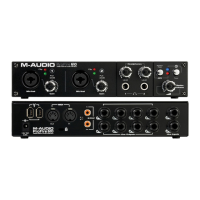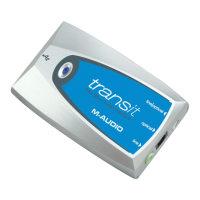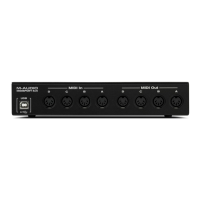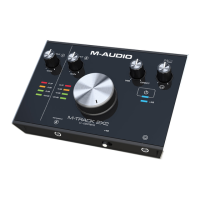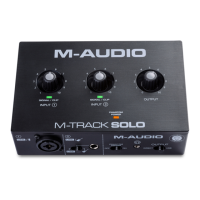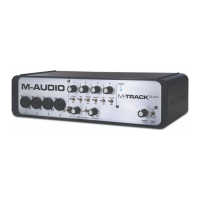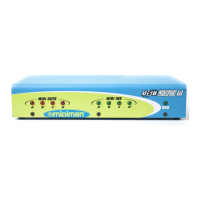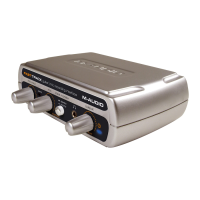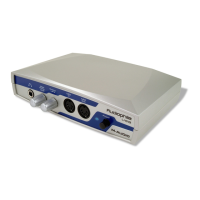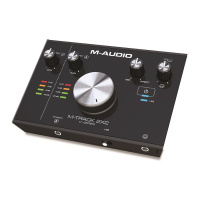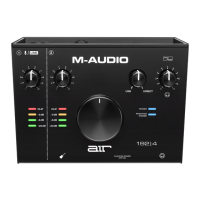Do you have a question about the M-Audio PROFIRE 2626 and is the answer not in the manual?
Lists the items included in the ProFire 2626 package, such as the interface, cables, power supply, and software.
Details the essential hardware and software specifications needed to operate the ProFire 2626.
Outlines the audio drivers and protocols supported by the ProFire 2626.
Suggests enhanced hardware and software configurations for optimal ProFire 2626 performance.
Describes the input/output jacks, buttons, and indicators on the ProFire 2626 front panel.
Details the various input/output ports and connectors located on the rear of the ProFire 2626.
Details the physical audio inputs on the ProFire 2626, including analog, ADAT, and S/PDIF.
Explains how the computer and DAW software interact with the ProFire 2626's audio streams.
Describes how audio outputs from the DAW are returned to the ProFire 2626.
Details the internal 18-input, 16-output DSP mixer for creating cue mixes and monitoring.
Explains the router's function in selecting audio sources for each hardware output.
Describes the physical outputs of the ProFire 2626, including analog and digital connections.
Explains how S/MUX modes reduce channel counts at higher sample rates (96kHz, 192kHz) for ADAT ports.
Provides access to the 18-input, 16-output DSP mixer for creating custom cue mixes.
Explains why software return channels may become disabled at higher sample rates.
Allows selection of audio sources for each hardware output pair on the interface.
Enables/disables groups of hardware inputs to conserve system resources.
Manages the number of software return streams to reduce FireWire bus demands.
Determines the order of input ports as they appear in audio software applications.
Configures interface operation when connected to a computer via FireWire.
Determines the clock source for synchronization, internal or external.
Sets the audio interface's sample rate, which can be application-dependent.
Adjusts input/output buffer sizes for optimal audio processing and latency.
Determines how the second pair of optical ports functions (ADAT or S/PDIF).
Sets the S/MUX mode for ADAT ports to handle high sample rates.
Assigns which analog output pairs the Master Volume knob controls.
Configures the behavior and display of meters within the DSP Mixer.
Enables use of the ProFire 2626 without a computer connected.
Sets the clock synchronization source when the interface operates in standalone mode.
Selects the sample rate for the interface when operating in standalone mode.
Configures the second optical port's mode (ADAT or S/PDIF) in standalone operation.
Details S/PDIF conversion capabilities when the unit is in standalone mode.
Provides access to file management (saving/loading settings) and help resources.
Allows saving, loading, and reverting Control Panel configurations to factory defaults.
Offers links to support, software updates, and product documentation online.
Illustrates physical connections for recording a guitarist/vocalist and percussionist.
Details how to connect instruments and microphones to the ProFire 2626 inputs.
Explains how to connect headphones and studio monitors for custom cue mixes.
Assigns input sources to the DSP Mixer channels for recording scenarios.
Configures the Router tab to send cue mixes to headphone outputs and monitors.
Assigns the Master Volume knob to control studio monitor levels.
Disables optical and S/PDIF inputs to conserve system resources.
Details how to create customized cue mixes for performers using the DSP mixer.
Notes that no inputs are required for this mixing-only scenario.
Connects ProFire 2626 analog outputs to six surround speakers.
Sets up software returns and disables unused inputs for surround mixing.
Configures the ProFire 2626 Router to send DAW surround mix channels to correct outputs.
Ensures Master Volume controls all six surround speakers simultaneously.
Addresses issues with Signal/Clip LED indicators not showing activity.
Troubleshoots problems where audio software shows no input meter activity.
Diagnoses and resolves issues causing clicks, pops, and other audio stream glitches.
Solves high latency and performance issues, particularly with Steinberg software.
Addresses issues where control panel settings are unavailable due to audio streaming.
Outlines the conditions and limitations of the M-Audio product warranty.
Guides users on how to register their product for full warranty coverage.
Lists the items included in the ProFire 2626 package, such as the interface, cables, power supply, and software.
Details the essential hardware and software specifications needed to operate the ProFire 2626.
Outlines the audio drivers and protocols supported by the ProFire 2626.
Suggests enhanced hardware and software configurations for optimal ProFire 2626 performance.
Describes the input/output jacks, buttons, and indicators on the ProFire 2626 front panel.
Details the various input/output ports and connectors located on the rear of the ProFire 2626.
Details the physical audio inputs on the ProFire 2626, including analog, ADAT, and S/PDIF.
Explains how the computer and DAW software interact with the ProFire 2626's audio streams.
Describes how audio outputs from the DAW are returned to the ProFire 2626.
Details the internal 18-input, 16-output DSP mixer for creating cue mixes and monitoring.
Explains the router's function in selecting audio sources for each hardware output.
Describes the physical outputs of the ProFire 2626, including analog and digital connections.
Explains how S/MUX modes reduce channel counts at higher sample rates (96kHz, 192kHz) for ADAT ports.
Provides access to the 18-input, 16-output DSP mixer for creating custom cue mixes.
Explains why software return channels may become disabled at higher sample rates.
Allows selection of audio sources for each hardware output pair on the interface.
Enables/disables groups of hardware inputs to conserve system resources.
Manages the number of software return streams to reduce FireWire bus demands.
Determines the order of input ports as they appear in audio software applications.
Configures interface operation when connected to a computer via FireWire.
Determines the clock source for synchronization, internal or external.
Sets the audio interface's sample rate, which can be application-dependent.
Adjusts input/output buffer sizes for optimal audio processing and latency.
Determines how the second pair of optical ports functions (ADAT or S/PDIF).
Sets the S/MUX mode for ADAT ports to handle high sample rates.
Assigns which analog output pairs the Master Volume knob controls.
Configures the behavior and display of meters within the DSP Mixer.
Enables use of the ProFire 2626 without a computer connected.
Sets the clock synchronization source when the interface operates in standalone mode.
Selects the sample rate for the interface when operating in standalone mode.
Configures the second optical port's mode (ADAT or S/PDIF) in standalone operation.
Details S/PDIF conversion capabilities when the unit is in standalone mode.
Provides access to file management (saving/loading settings) and help resources.
Allows saving, loading, and reverting Control Panel configurations to factory defaults.
Offers links to support, software updates, and product documentation online.
Illustrates physical connections for recording a guitarist/vocalist and percussionist.
Details how to connect instruments and microphones to the ProFire 2626 inputs.
Explains how to connect headphones and studio monitors for custom cue mixes.
Assigns input sources to the DSP Mixer channels for recording scenarios.
Configures the Router tab to send cue mixes to headphone outputs and monitors.
Assigns the Master Volume knob to control studio monitor levels.
Disables optical and S/PDIF inputs to conserve system resources.
Details how to create customized cue mixes for performers using the DSP mixer.
Notes that no inputs are required for this mixing-only scenario.
Connects ProFire 2626 analog outputs to six surround speakers.
Sets up software returns and disables unused inputs for surround mixing.
Configures the ProFire 2626 Router to send DAW surround mix channels to correct outputs.
Ensures Master Volume controls all six surround speakers simultaneously.
Addresses issues with Signal/Clip LED indicators not showing activity.
Troubleshoots problems where audio software shows no input meter activity.
Diagnoses and resolves issues causing clicks, pops, and other audio stream glitches.
Solves high latency and performance issues, particularly with Steinberg software.
Addresses issues where control panel settings are unavailable due to audio streaming.
Outlines the conditions and limitations of the M-Audio product warranty.
Guides users on how to register their product for full warranty coverage.
| Audio Interface Type | FireWire |
|---|---|
| Number of Preamps | 8 |
| A/D Resolution | 24-bit |
| MIDI I/O | In/Out |
| Phantom Power | Yes |
| Headphone Outputs | 2 x 1/4" |
| Simultaneous Channels of I/O | 26 |
| Sample Rate | Up to 192kHz |
| Bit Depth | 24-bit |
| FireWire Ports | 2 |
| Analog Inputs | 8 x XLR/TRS Combo |
| Analog Outputs | 8 x TRS |
| Digital Inputs | 2 x ADAT, 1 x S/PDIF |
| Digital Outputs | 2 x ADAT, 1 x S/PDIF |
| Wordclock I/O | In/Out |
| Software Included | Pro Tools M-Powered |
